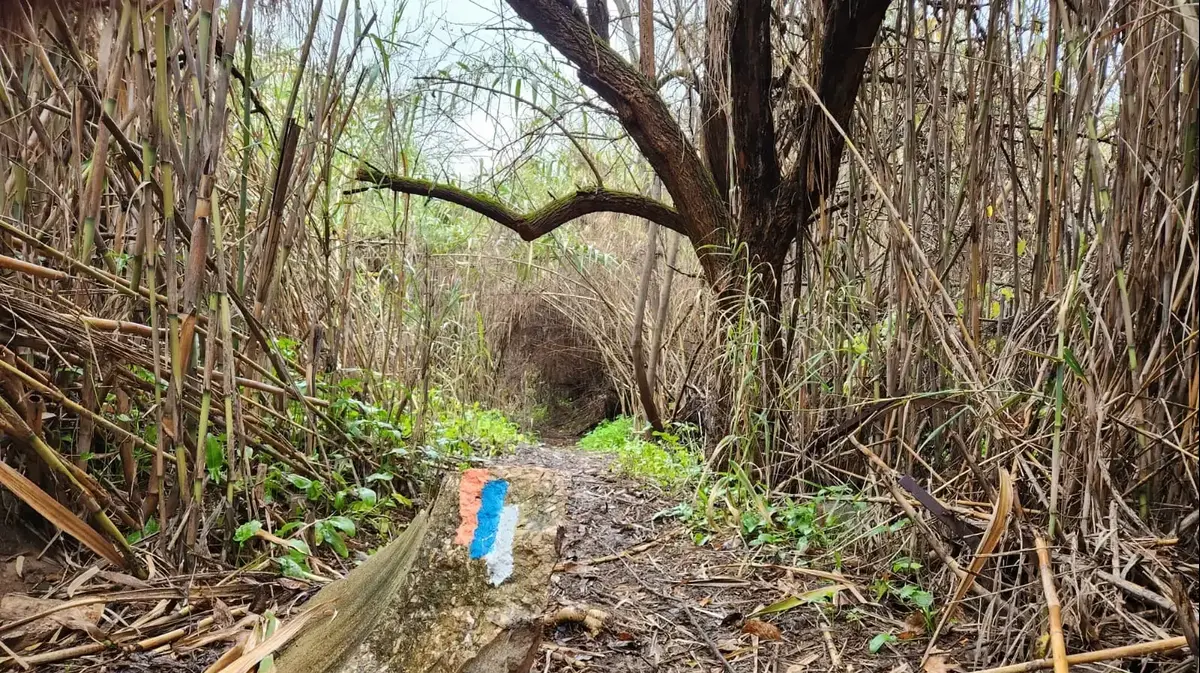In the video: "The park is at its peak, it's a shame people aren't here to enjoy themselves": the contrast in Kiryat Shmona 02.14.24/Eli Ashkenazi
It is hard to imagine a bigger gap than the anti-tank missiles hit on Wednesday in Safed that led to the death of an IDF soldier, and the day before in Kiryat Shmona that led to the injury of a mother and her son, and the flooding of Nahal Ein Zahav, a five-minute walk away.
"The park is at its peak, it's a shame people aren't here to enjoy themselves," said Dodi Selma, an employee of the municipal company KSH and the manager of the park, sadly. He walked along the bank of the river, riding an ATV. Just him, the trees, the thicket of reeds, birds and the stream of water rushing south , among the empty tenements.
The Israel Trail on the bank of Nahal Ein Zahav/Eli Ashkenazi
Dodi Selma, the director of the park/Eli Ashkenazi
The painful attacks this week in Kiryat Shmona and Safed, and then the massive wave of air force attacks in Lebanon, deepened the sense of tension and uncertainty in the north.
In Safed, after the barrage on the city, they tried to return to some kind of routine;
The students remained in the educational institutions and the businesses remained open.
Only the city market, which operates on Wednesdays, is closed.
But in Kiryat Shmona the routine in the last four months is the routine of an abandoned and sad city.
Few cars are seen on the city streets.
No pedestrians.
The shops are closed.
21 thousand residents of the city are scattered throughout the country and only 3000 residents remain, Selma is one of them.
According to him, he did not for a moment think of leaving.
"This is my home, I've already been through more difficult times here, of heavy gunfire."
Along with the sadness that accompanies him to see the city empty, he says that he and his work team members who remain with him are using this period for many jobs.
Among other things, they are now establishing a garden in memory of Yoel Langhal, a young man from the Galilee, who was murdered in Kiryat Shmona.
Barracks from the Khalsa crossing in the Golden Park/Eli Ashkenazi
Ein Zahav Park is in the eye of Selma.
The park that covers an area of 110 dunams is a green lung in the heart of the city, it has lawns, trees and bushes and the channel of Nahal Ein Zahav crosses it.
In the early days of Kash, the stream was a meeting point for the residents and had an important place in the life of the town. The children bathed in it and even washed their clothes in a small waterfall that was nicknamed the "Kurdish spring" by the founders. Over the years, the stream and the park were neglected, the residents stopped coming to it, and later The flow of water almost stopped. The water was pumped for domestic consumption and for the spring water plant.
About 15 years ago, a group of residents arose in the city to fight to revive the stream and return Atara to its former glory. They blocked a construction plan on the edge of the park and, contrary to all the skeptics, succeeded in getting the establishment to restore the flow of water to the stream. The company For the protection of nature, the municipality of Kash and the Kinneret Drainage and Streams Authority embraced the project and the park became an urban nature site that there is no other city in Israel that has been awarded such an impressive site.
In the heart of the park, they also made sure to recreate a number of barrack models, identical to the barracks of the transit where the founders of the place lived.
"I was born here and I stay here and no one will take me out of here."
Ein Zahav Park/Eli Ashkenazi
South of the city, the stream flows into the western channel of the Hula valley leading to Jordan and the Sea of Galilee.
In the center of the stream is a section that was nicknamed "The Jungle" by Kiryat Shmona veterans, where a natural riparian forest has been preserved.
Selma leads to the "Jungle" condenser and turns off the ATV.
The noise of the water flow is so in contrast to the noise of gunfire that took over the north.
"It's sad that now, at the height of the beauty of the stream, the place is empty, just like I'm sad to see the city empty," said Selma.
"But I'm not leaving, I was born here and I'm staying here and no one will take me out of here," he declared.
He is already looking forward to the day after the war, when, according to him, the residents of the city and many visitors from outside will return to the park and the stream.
More on the same topic:
Park
Kiryat Shmona
missiles
NT

